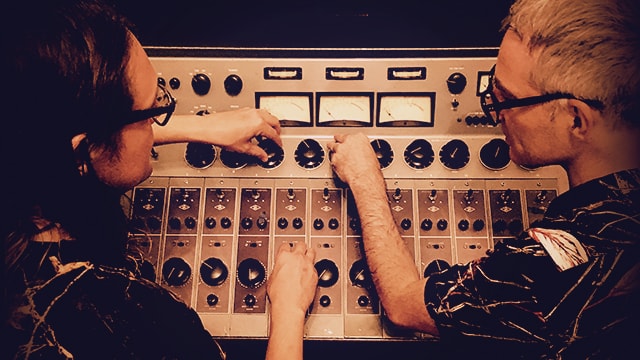The Neve 33609C Buss Compressor
Editor’s Note: This article was originally featured in a previous edition of our Webzine. It has been selected for reprint because of the unit’s ongoing relevance and availability as a UAD Powered Plug-In.
Call me stubborn, but I don't often use compressors/limiters designed past the 1960s. Sure, I've used dbx compressors, and have worked with the Distressor, which I think does a great job of approximating an 1176 using VCA technology. However I've never been all that impressed with most modern compressors. I've found they don't have much character, or that the character, when run at heavy settings, is far from musical. Not that all compressors need to have character. Sometimes compressors and limiters should be transparent, and quietly sit back to do their job. However, I recently got the chance to audition both the Neve 33609C and a Neve 33609J, and I see now what I've been missing. The Neve 33609 was released in 1985, making it a relatively "modern" compressor, and evolved from classics like the Neve 2254 compressor.

The 33609 is divided into two sections, with all stepped controls for instant recall. From left to right the user is presented first with limiter controls, and then compression controls. In the circuit, the compressor section comes first and the limiter second, as would be expected. The physical layout is an inherent idiosyncrasy with all Neve compressors, and part of the charm, if you will. Threshold and recovery controls are present with six release times available, two of which achieve program-dependent release, much like the Fairchild. The limiter also features a slow and fast attack switch that I found somewhat subtle.
The compressor has similar threshold and recovery controls as the limiter, plus ratio selection and makeup gain. The unit also has global gain reduction bypass, and both compressor and limiter sections have individual bypass. Both the 33609C and 33609J have a stereo link switch, and the C also has a position for quad linking. Awesome!
Because of its design, the 33609 is most widely known as a stereo buss compressor. On the mix buss the 33609 is typically run at moderate settings (low compression ratio, slow release, minimal threshold). Using it this way on the master output of my DAW, I found that the 33609 gave a very nice "analog glue" to the mixes, and I found that I performed less tweaking on individual tracks that I might normally need. I don't usually track while a compressor is on the master output, but it was an experience that could be habit forming. Luckily, the 33609J unit is now in UA's permanent possession.
The 33609 had a ton of character when hit hard with a fast release — it's a character I've never heard from a compressor.
I next inserted the 33609 on the buss of a rock drum kit and was floored. The 33609 had a TON of character when hit hard with a fast release--it's a character I've never heard from a compressor. The best way I can describe it is that the release was reminiscent of a slamming 1176 — but tighter; it was a very controlled modern attack that smoothes the transient without dulling it.
I did some tracking with the 33609 as well, recording horn and string overdubs. I tried it on baritone sax with the program dependent release, using a Royer 121 and 2-610 pre full up, getting 4 to 6 dB of reduction. The horn fattened up nicely and so did the room, and again had a beautiful modern-yet-classic compression characteristic. I also tried the 33609 on cello, with the same signal path. The cello carried the bass in the song, and the 33609 made it sit just right — no fader moves on mixdown but with plenty of dynamics in the performance.
You may have noticed I make little distinction between the C rev and the J. Be assured, that was intentional. I've heard rumors that the re-issues are not the same as the originals. Hooey. UA's own Dr. Dave Berners scrutinized the schematics and components in every way, and found them to be identical — with the exception of the relay network that makes the J remote-controllable. In listening tests they sounded exactly the same as well.
I'd say the experience opened my mind to looking at modern compressors a bit more, but at the same time it's hard to see the 33609 as a modern compressor, as it has so much character. Either way, I frickin' love it!
— Will Shanks
-
On Sale
Neve 1081 / 1081SE Classic Console EQ
Add to CartRegular Price: $249.00
$149.00
You'll Save 40%
-
On Sale
Neve 31102 / 31102SE Classic Console EQs
Add to CartRegular Price: $249.00
$149.00
You'll Save 40%
Read More
Recording Lyrics Born with Apollo’s Unison™ Technology
We chatted with Hamilton about his hybrid analog/digital recording studio, how he implements UAD plug-ins and Unison technology in his workflow, and the session he produced at at Studio G, his multi-room Brooklyn recording facility, tracking hip-hop artist Lyrics Born.
Joel Hamilton w/ Lyrics Born
Watch producer/engineer Joel Hamilton (Tom Waits, Pretty Lights) record Lyrics Born through the Apollo interface and Unison™-enabled UAD Powered Plug-Ins as they perform the track, “Don't Change”
Tracking Arcade Fire With the Iconic UA 610 Console & Apollo
Learn how producer Steve Mackey (M.I.A., Florence and the Machine) used an original, and rare, Bill Putnam-designed UA 610 console — along with Apollo interfaces — on Arcade Fire's album, Everything Now.




